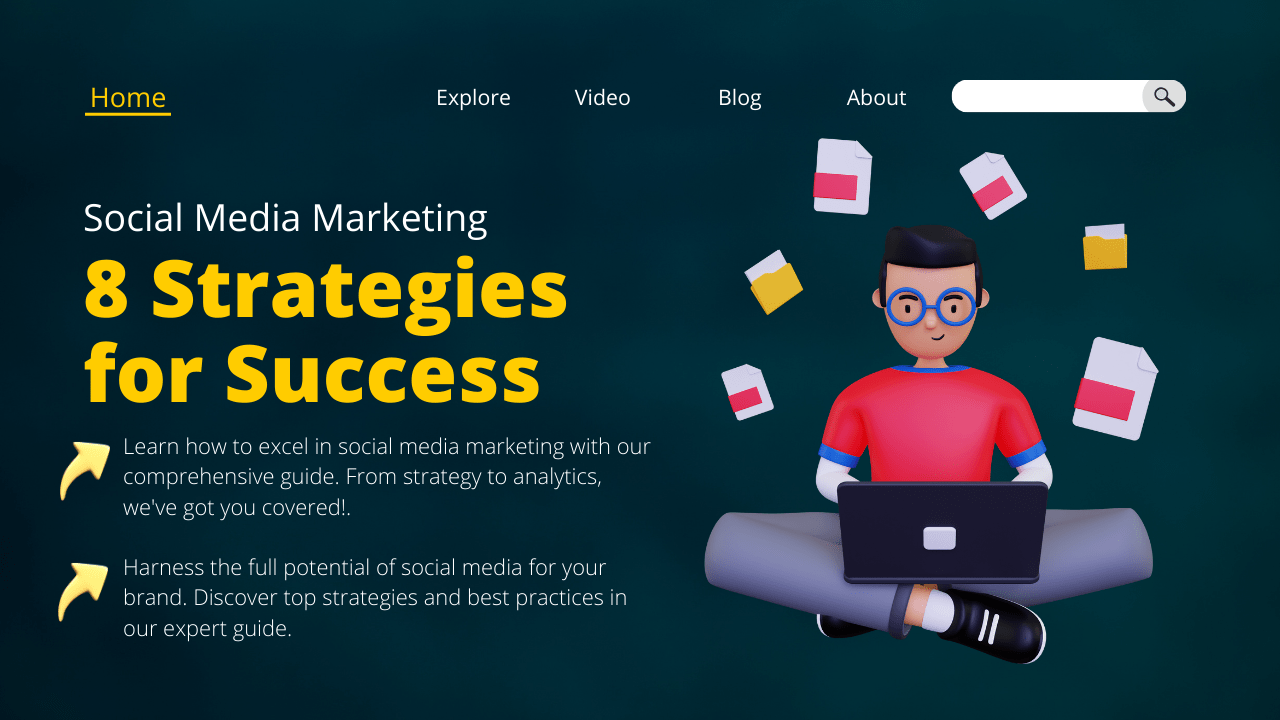7 SEO Strategies for Dominating Content Marketing
Understanding the Foundations of SEO
In the dynamic landscape of online visibility, mastering the foundations of SEO is the first step toward content marketing dominance. Here, we delve into the essential aspects that form the bedrock of a successful SEO strategy.
Importance of Search Engine Algorithms
Search engines, such as Google, employ sophisticated algorithms to determine the relevance and authority of web content. These algorithms are continually evolving, making it crucial for digital marketers to stay abreast of updates. Understanding the principles behind these algorithms empowers you to optimize your content effectively.
How to Implement:
- Continuous Learning: Regularly engage with SEO news, attend webinars, and participate in online forums to stay informed about algorithm updates.
- Adaptation: Adjust your SEO strategy in response to major algorithm changes, ensuring your content remains in harmony with the latest search engine requirements.
User Intent and Its Significance
SEO success goes beyond simply incorporating keywords into your content. It involves aligning your material with the intent behind user searches. Recognizing user intent helps you create content that not only ranks well but also satisfies the needs of your target audience.
How to Implement:
- Keyword Intent Analysis: Explore the variety of user intent behind specific keywords. Tailor your content to address informational, navigational, or transactional queries.
- User-Focused Content: Craft content that fulfills the expectations of users, providing them with valuable information or solutions to their queries.
Holistic SEO Approach
A holistic approach to SEO recognizes that various factors contribute to online visibility. It’s not just about keywords but also about user experience, website structure, and the quality of your content. Building a comprehensive SEO strategy involves considering all these elements.
How to Implement:
- Technical SEO: Optimize your website’s technical aspects, including site speed, mobile responsiveness, and crawlability.
- Content Quality: Prioritize high-quality content that addresses user needs and adds value to your target audience.
Understanding the foundations of SEO requires a combination of technical knowledge, adaptability, and a user-centric mindset. By grasping the intricacies of search engine algorithms and aligning your content with user intent, you set the stage for a robust SEO strategy that can propel your content marketing efforts to new heights.

Keyword Research: The Bedrock of Dominating Content Marketing
The importance of effective keyword research cannot be overstated. It serves as the bedrock upon which a successful digital strategy is built. Let’s explore the nuances of this crucial step and how it can significantly impact your online presence.
Identifying Top-Level and Longtail Keywords
Top-Level Keywords
Top-level keywords are broad terms that encompass the primary theme of your content. While these keywords attract significant search volume, they also face intense competition.
How to Implement:
- Research Tools: Utilize keyword research tools like Google Keyword Planner, SEMrush, Ahrefs oor Sitechecker to identify top-level keywords relevant to your industry.
- Relevance: Ensure the chosen keywords align closely with your content and business objectives.
Longtail Keywords
Longtail keywords are more specific, often comprising three or more words. While they may have lower search volume, they are valuable for targeting niche audiences and capturing users with specific intent.
How to Implement:
- User Queries: Identify common questions or specific queries related to your industry.
- Content Alignment: Craft content that directly addresses these longtail keywords to meet the specific needs of your audience.
Incorporating a Mix of Keywords
A successful SEO strategy involves striking a balance between top-level and longtail keywords. While top-level keywords contribute to broad visibility, longtail keywords allow you to cater to a more targeted audience.
How to Implement:
- Content Structure: Organize your content to naturally incorporate both top-level and longtail keywords.
- Diversification: Avoid over-reliance on a single keyword; diversify your keyword usage to broaden your reach.
Staying Updated with Industry Trends
The digital landscape evolves rapidly, and so do search trends. Keeping your keyword strategy current ensures your content remains relevant and aligns with the changing needs of your audience.
How to Implement:
- Periodic Audits: Conduct regular keyword audits to identify shifts in search behavior.
- Competitor Analysis: Monitor competitors and industry leaders to stay ahead in adapting to emerging keyword trends.
Adapting to Algorithm Changes
Search engine algorithms undergo continuous refinement. Adapting your keyword strategy to align with these changes is vital for maintaining and improving your search rankings.
How to Implement:
- Algorithm Updates: Stay informed about major algorithm updates from search engines.
- Keyword Relevance: Regularly assess the relevance of your chosen keywords and adjust them based on algorithmic changes.
Effective keyword research forms the foundation of a successful content marketing strategy. By identifying and incorporating top-level and longtail keywords, staying abreast of industry trends, and adapting to algorithm changes, you set the stage for a robust SEO approach that maximizes your online visibility and audience engagement.

Optimizing On-Page Elements
Optimizing on-page elements is a pivotal aspect of any successful SEO strategy. It involves fine-tuning the elements directly within your web pages to enhance both user experience and search engine visibility. Let’s delve into the key components and strategies for effective on-page optimization.
Craft Compelling Title Tags
Title tags are the first interaction users have with your content on search engine result pages. Crafting compelling and concise title tags not only captures attention but also plays a crucial role in search engine rankings.
How to Implement:
- Keyword Inclusion: Integrate target keywords naturally into your title tag.
- Clarity and Relevance: Ensure the title clearly reflects the content’s subject matter and relevance to user queries.
Meta Descriptions for Engagement
Meta descriptions provide a brief overview of your content. While they don’t directly impact rankings, well-crafted meta descriptions can significantly improve click-through rates.
How to Implement:
- Enticing Copy: Create engaging and concise meta descriptions that encourage users to click.
- Relevance: Align meta descriptions with the content to set accurate expectations for the audience.
Structuring Content with Headers and Sub-Headers
A well-organized content structure not only aids user readability but also assists search engines in understanding the hierarchy and relevance of your information.
How to Implement:
- Hierarchy: Use headers (H1, H2, H3, etc.) to organize content hierarchically.
- Keyword Placement: Incorporate relevant keywords in headers to reinforce the content’s topic.
User-Friendly URL Structure
A clean and descriptive URL structure enhances user experience and provides search engines with valuable information about the content.
How to Implement:
- Conciseness: Keep URLs concise, avoiding unnecessary characters or parameters.
- Keyword Inclusion: Integrate primary keywords into the URL, maintaining clarity and relevance.
Image Optimization
Images contribute to a richer user experience, but they also need optimization for search engines to understand their content.
How to Implement:
- Alt Text: Include descriptive alt text for images with relevant keywords.
- File Size: Optimize image file sizes to ensure fast page loading times.
Mobile Responsiveness
With an increasing number of users accessing content on mobile devices, ensuring your website is mobile-friendly is imperative for SEO success.
How to Implement:
- Responsive Design: Adopt a responsive design that adapts to different screen sizes.
- Mobile Page Speed: Optimize page speed for mobile users to enhance overall user experience.
Page Loading Speed
Page loading speed directly impacts user satisfaction and search engine rankings. Faster-loading pages are favored by both users and search algorithms.
How to Implement:
- Image Compression: Compress images to reduce file sizes.
- Minimize HTTP Requests: Limit the number of elements requiring server requests for faster loading.
Optimizing on-page elements is an ongoing process that demands attention to detail and a commitment to providing the best possible user experience. By focusing on title tags, meta descriptions, content structure, mobile responsiveness, and page loading speed, you pave the way for enhanced search engine visibility and improved user engagement.

Creating High-Quality, Shareable Content
High-quality, shareable content serves as the cornerstone of a successful content marketing strategy. Crafting content that not only resonates with your audience but also encourages sharing amplifies your online presence and fosters brand advocacy. Let’s explore the key elements and strategies for creating such impactful content.
Prioritize Quality and Relevance
Quality content is not just about meeting word count quotas; it’s about providing genuine value to your audience. Prioritize relevance, accuracy, and usefulness in every piece you produce.
How to Implement:
- Thorough Research: Invest time in researching your topic to provide in-depth and accurate information.
- Clear Messaging: Communicate your message concisely and clearly to keep your audience engaged.
Understand Your Audience
Tailoring your content to the preferences and needs of your target audience is essential for creating content that resonates and compels them to share.
How to Implement:
- Audience Research: Understand the demographics, interests, and pain points of your audience.
- User Personas: Create user personas to guide content creation with a deep understanding of your target audience.
Incorporate Visual Elements
Visuals, such as images, infographics, and videos, enhance the overall appeal of your content. People are more likely to share content that includes eye-catching visuals.
How to Implement:
- Engaging Visuals: Use high-quality and relevant images to complement your text.
- Infographics and Videos: Present information through visually appealing formats to increase shareability.
Encourage Social Sharing
Include easy-to-use social sharing buttons to facilitate the seamless sharing of your content across various social media platforms.
How to Implement:
- Strategic Placement: Position social sharing buttons prominently within your content.
- Calls to Action: Encourage readers to share by incorporating calls to action that highlight the benefits of sharing.
Create Shareable Headlines
Compelling headlines grab attention and encourage users to click and share. Craft headlines that evoke curiosity or offer a clear benefit.
How to Implement:
- Clarity and Conciseness: Keep headlines clear and concise while maintaining an element of intrigue.
- Keyword Integration: Include relevant keywords in your headlines for SEO benefits.
Foster Community Engagement
Building a community around your content encourages ongoing engagement and sharing. Respond to comments, ask questions, and create a sense of belonging for your audience.
How to Implement:
- Active Participation: Engage with your audience through comments, polls, and discussions.
- User-Generated Content: Encourage users to contribute content or share their experiences related to your brand.
Utilize Storytelling Techniques
Humans are wired to connect with stories. Incorporate storytelling elements into your content to evoke emotions and create a memorable impact.
How to Implement:
- Narrative Structure: Structure your content with a clear beginning, middle, and end.
- Personalization: Share relatable anecdotes or case studies to make your content more personal and shareable.
Creating high-quality, shareable content is an ongoing process that requires a deep understanding of your audience, strategic use of visuals, and a commitment to storytelling. By prioritizing relevance, incorporating engaging visuals, and fostering community engagement, you not only enhance your online visibility but also establish a meaningful connection with your audience that goes beyond the digital realm.

Leveraging Social Media for SEO
The synergy between social media and SEO has become a crucial factor in determining online success. Leveraging social media effectively not only enhances your brand’s visibility but also plays a pivotal role in influencing your website’s search engine rankings. Let’s explore the strategies and best practices for maximizing the impact of social media on your SEO efforts.
Choose the Right Social Platforms
Not all social media platforms are created equal. Select platforms that align with your target audience and industry. Focus on those where your audience is most active to maximize engagement and visibility.
How to Implement:
- Audience Analysis: Understand the demographics and preferences of your target audience.
- Platform Selection: Choose social media platforms based on audience demographics and the nature of your content.
Optimize Social Profiles for Search
Social media profiles often appear in search engine results. Optimize your profiles with relevant keywords, a concise yet informative bio, and a link to your website.
How to Implement:
- Keyword Integration: Integrate relevant keywords in your social media profiles.
- Consistent Branding: Maintain consistent branding across all social platforms to enhance brand recognition.
Share SEO-Optimized Content
When sharing content on social media, ensure that it is optimized for SEO. Craft compelling captions and use relevant hashtags to broaden the reach of your posts.
How to Implement:
- Keyword Inclusion: Incorporate target keywords naturally in your social media posts.
- Hashtag Strategy: Research and use trending and industry-specific hashtags to increase discoverability.
Foster Engagement and Build Community
Social signals, such as likes, shares, and comments, are considered by search engines as indicators of content quality and relevance. Foster engagement to enhance your content’s visibility on search engine results pages.
How to Implement:
- Active Participation: Respond promptly to comments and messages to build a sense of community.
- User-Generated Content: Encourage users to create and share content related to your brand.
Utilize Social Sharing Buttons on Your Website
Integrate social sharing buttons on your website to facilitate the easy sharing of your content. This not only amplifies your reach but also signals search engines that your content is valuable.
How to Implement:
- Visible Placement: Position social sharing buttons prominently on your web pages.
- User-Friendly Design: Ensure the buttons are easy to use across various devices.
Leverage Social Media Advertising
Paid social media advertising can complement your organic efforts by reaching a broader audience. Utilize targeted ads to drive traffic to your website and increase brand visibility.
How to Implement:
- Audience Segmentation: Define specific audience segments for your social media ads.
- Ad Optimization: Continuously monitor and optimize ad performance based on engagement and conversion metrics.
Analyze Social Media Insights
Regularly analyze social media insights to understand what resonates with your audience. Use this data to refine your social media strategy and create content that aligns with your audience’s preferences.
How to Implement:
- Metrics Analysis: Monitor key metrics such as reach, engagement, and click-through rates.
- A/B Testing: Experiment with different types of content and posting schedules to identify optimal strategies.
Leveraging social media for SEO is a dynamic and multifaceted process. By choosing the right platforms, optimizing profiles, sharing SEO-optimized content, fostering engagement, and utilizing social media advertising, you can create a powerful synergy that not only enhances your brand’s online presence but also positively influences your search engine rankings.

Building Quality Backlinks
Building quality backlinks is a fundamental aspect of SEO that directly impacts your website’s authority and search engine rankings. While the quantity of backlinks matters, the quality of those links is paramount. Let’s explore in detail the strategies and best practices for acquiring high-quality backlinks to enhance your website’s SEO.
Focus on Relevant and Authoritative Websites
Quality backlinks come from websites that are relevant to your industry and have established authority. Prioritize building connections with websites that share thematic alignment with your content.
How to Implement:
- Industry Research: Identify authoritative websites within your industry or niche.
- Relationship Building: Establish genuine relationships with webmasters and content creators in your field.
Create High-Quality, Link-Worthy Content
The foundation of acquiring quality backlinks is to create content that is informative, unique, and valuable. Such content naturally attracts links from other websites seeking valuable resources for their audience.
How to Implement:
- Comprehensive Content: Produce in-depth, comprehensive content that addresses common queries within your industry.
- Visual Appeal: Incorporate engaging visuals, infographics, and multimedia elements to enhance the overall quality of your content.
Guest Blogging on Reputable Platforms
Guest blogging on authoritative websites allows you to showcase your expertise and earn backlinks in return. Choose platforms that align with your industry and have a solid reputation.
How to Implement:
- Targeted Outreach: Identify reputable blogs or websites that accept guest contributions.
- Pitching Value: Craft personalized pitches that emphasize the value you bring to their audience.
Utilize Broken Link Building
Broken link building involves identifying broken links on other websites and offering your content as a replacement. This strategy provides value to the website owner while earning you a valuable backlink.
How to Implement:
- Link Analysis: Use tools to identify broken links on relevant websites.
- Content Pitch: Reach out to the website owner, notifying them of the broken link and suggesting your content as a suitable replacement.
Participate in Industry Forums and Communities
Active participation in industry forums and online communities not only establishes your presence but also provides opportunities for natural link building through shared content and discussions.
How to Implement:
- Engagement: Contribute meaningful insights to discussions within industry forums.
- Content Sharing: Share relevant content from your website when appropriate, adding value to the community.
Collaborate with Influencers and Thought Leaders
Influencers and thought leaders in your industry can significantly impact your backlink profile. Collaborate with them through interviews, joint projects, or co-authored content to gain exposure and valuable backlinks.
How to Implement:
- Influencer Outreach: Establish connections with influencers through social media or email.
- Collaboration Proposals: Propose mutually beneficial collaborations that include backlink opportunities.
Monitor and Disavow Unwanted Backlinks
Regularly monitor your backlink profile to identify and disavow low-quality or spammy links. Maintaining a clean backlink profile is essential for preserving your website’s credibility.
How to Implement:
- Backlink Audits: Use tools to conduct regular audits of your backlink profile.
- Disavow Tool: Disavow unwanted or harmful backlinks through Google’s Disavow Tool.
Building quality backlinks is an ongoing process that requires strategic planning and continuous effort. By focusing on relevance, creating high-quality content, utilizing guest blogging, broken link building, participating in industry communities, collaborating with influencers, and maintaining a vigilant approach to your backlink profile, you can enhance your website’s authority and significantly improve its search engine rankings.

Monitoring and Adapting: The SEO Lifecycle
Success isn’t a one-time achievement but an ongoing process that demands continuous monitoring, analysis, and adaptation. Understanding and actively participating in the SEO lifecycle is crucial for maintaining and improving your website’s search engine rankings. Let’s explore in detail the key components of monitoring and adapting in the SEO journey.
Regularly Track Keyword Rankings
Keyword rankings are a vital indicator of your website’s visibility on search engine result pages. Regularly monitor the performance of your target keywords to identify trends and opportunities.
How to Implement:
- SEO Tools: Utilize tools like SEMrush, Ahrefs or Sitechecker to track keyword rankings over time.
- Competitor Analysis: Benchmark your rankings against competitors to identify areas for improvement.
Analyze Website Traffic and User Behavior
Understanding how users interact with your website provides valuable insights for optimization. Analyze website traffic, user behavior, and conversion metrics to identify areas for improvement.
How to Implement:
- Google Analytics: Use Google Analytics to track website traffic, user demographics, and behavior.
- Conversion Tracking: Set up conversion tracking to monitor the effectiveness of your SEO efforts in achieving desired goals.
Conduct Regular SEO Audits
SEO audits involve a comprehensive review of your website’s technical aspects, on-page elements, and backlink profile. Regular audits help identify issues and ensure your site adheres to best practices.
How to Implement:
- Audit Tools: Utilize SEO audit tools to identify technical issues and opportunities for improvement.
- Content Review: Evaluate the relevance and effectiveness of your on-page content during audits.
Stay Informed About Algorithm Updates
Search engine algorithms undergo continuous updates, impacting how websites are ranked. Stay informed about these updates to adapt your SEO strategy accordingly.
How to Implement:
- Industry News: Follow reputable SEO news sources to stay informed about algorithm changes.
- Webmaster Guidelines: Regularly review and adhere to search engine webmaster guidelines for best practices.
Adapt to Changing Industry Trends
Industries evolve, and so do user behaviors and expectations. Adapt your SEO strategy to align with changing industry trends and emerging technologies.
How to Implement:
- Market Research: Stay updated on industry trends through market research and competitor analysis.
- User Feedback: Gather and analyze user feedback to identify areas for improvement and innovation.
Embrace Mobile Optimization
As the majority of internet users access content on mobile devices, optimizing your website for mobile is imperative. Google also considers mobile-friendliness as a ranking factor.
How to Implement:
- Responsive Design: Ensure your website design is responsive and adapts to various screen sizes.
- Mobile Page Speed: Optimize page speed for mobile users to enhance user experience.
Implement Technical SEO Best Practices
Technical SEO ensures that search engines can crawl, index, and understand your website effectively. Regularly implement and update technical SEO best practices.
How to Implement:
- Sitemap Submission: Submit XML sitemaps to search engines for efficient crawling.
- Robots.txt: Use a well-structured robots.txt file to guide search engine bots on which pages to crawl or avoid.
Utilize Data for Informed Decision-Making
Data-driven decision-making is fundamental to successful SEO. Analyze data regularly to make informed decisions about strategy adjustments and optimizations.
How to Implement:
- Regular Reporting: Create and review regular reports on key SEO metrics.
- A/B Testing: Experiment with different strategies and analyze performance data to identify what works best.
The SEO lifecycle is a continuous loop of monitoring, analysis, and adaptation. By regularly tracking keyword rankings, analyzing website traffic, conducting SEO audits, staying informed about algorithm updates, adapting to industry trends, embracing mobile optimization, implementing technical SEO best practices, and utilizing data for decision-making, you ensure that your SEO strategy remains effective and responsive to the evolving digital landscape.
Conclusion
In the ever-evolving realm of digital marketing, mastering SEO strategies for dominating content marketing is essential for online success. This comprehensive guide has delved into crucial aspects, from understanding the foundations of SEO to building quality backlinks and navigating the SEO lifecycle. By implementing the outlined strategies, you can propel your content marketing efforts to new heights, driving increased visibility, engagement, and success in the competitive digital landscape.
Key Takeaways
- Holistic Approach: SEO success requires a holistic approach that considers not only keywords but also user experience, content quality, and technical aspects.
- Quality Over Quantity: Prioritize creating high-quality, shareable content that adds value to your audience, fostering organic engagement and brand advocacy.
- Strategic Social Media Integration: Leverage social media not just for brand visibility but also as a powerful tool for SEO through content sharing, engagement, and collaboration.
- Continuous Adaptation: SEO is dynamic. Regularly monitor keyword rankings, analyze user behavior, and adapt your strategy to algorithm updates and industry trends.
- Data-Driven Decision-Making: Use data to inform your decisions. Regularly analyze metrics, conduct SEO audits, and implement changes based on performance insights.
FAQs
1. How long does it take to see results from SEO strategies?
The timeline for SEO results varies based on factors like industry competition, the quality of your SEO efforts, and the responsiveness of search engines. Generally, noticeable improvements can take several months, with ongoing efforts yielding more significant and sustained results over time.
2. Is social media really crucial for SEO?
Yes, social media plays a crucial role in SEO. Social signals, such as likes, shares, and comments, can influence search engine rankings. Additionally, social media platforms provide opportunities for content distribution, brand exposure, and building backlinks.
3. How often should I conduct SEO audits?
Regular SEO audits are essential for maintaining a healthy website. Conduct them quarterly or at least twice a year to identify technical issues, optimize on-page elements, and ensure your site aligns with the latest SEO best practices.
4. Can I solely focus on on-page SEO and neglect off-page strategies?
While on-page SEO is crucial, neglecting off-page strategies, such as building quality backlinks, may limit your overall SEO success. A balanced approach that combines on-page and off-page optimization is key to achieving comprehensive and sustainable results.
5. How do I stay updated on SEO industry trends?
Stay informed by regularly reading reputable SEO blogs, following industry leaders on social media, and participating in webinars or conferences. Additionally, monitor search engine guidelines and algorithm updates to adapt your strategy accordingly.
Photo by Pexels

















